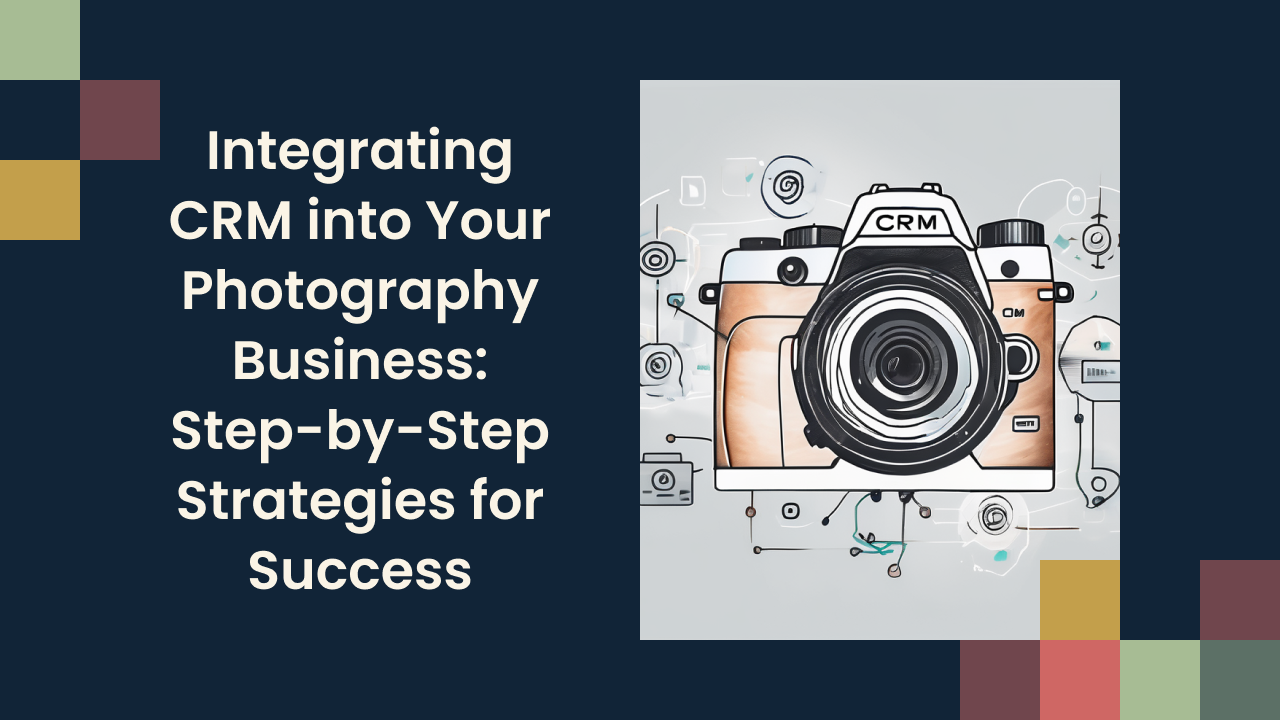Integrating CRM into Your Photography Business: Step-by-Step Strategies for Success
Building strong client relationships is crucial for business success. One effective way to achieve this is by integrating Customer Relationship Management (CRM) into your photography business. CRM provides a systematic approach to managing your interactions with clients, enabling you to deliver personalized experiences and drive customer loyalty. In this article, we will guide you through step-by-step strategies to successfully integrate CRM into your photography business.
Understanding the Role of CRM in Photography Business
Before diving into CRM integration, it's important to understand the concept and its significance in the photography industry.
Photography businesses thrive on capturing moments and creating lasting memories for their clients. However, in today's competitive market, it's not just about the quality of the photos but also about the overall experience provided to clients. This is where Customer Relationship Management (CRM) plays a crucial role.
Defining CRM and Its Importance
CRM refers to a set of tools and strategies that help businesses manage their interactions and relationships with existing and potential clients. In the context of photography, CRM helps streamline communication, track client preferences, and provide a seamless experience from booking to delivery.
Implementing a CRM system in your photography business can revolutionize the way you interact with clients. It allows you to centralize client information, including contact details, past photo shoot preferences, special occasions, and more. This holistic view of each client enables you to tailor your services to their specific needs, creating a personalized and memorable experience.
By implementing CRM, you can enhance client satisfaction, increase repeat business, and attract new clients through positive referrals.
How CRM Enhances Client Relationships in Photography
CRM allows you to store and analyze client data, enabling you to personalize your services based on individual preferences and past interactions. By understanding your clients better, you can tailor your approach, anticipate their needs, and provide a personalized experience that sets you apart from competitors.
Additionally, CRM helps you manage your appointments, inquiries, and follow-ups in a structured manner, reducing the likelihood of missed opportunities and ensuring timely communication with clients. This level of professionalism and responsiveness builds trust and strengthens the client-photographer relationship.
Furthermore, CRM systems can provide valuable insights into client behavior and preferences, allowing you to identify trends, popular photography styles, and peak booking times. This data-driven approach not only helps you make informed business decisions but also enables you to proactively reach out to clients with personalized offers or reminders, enhancing engagement and loyalty.
Evaluating Your Photography Business Needs
Before integrating CRM, it is essential to identify the specific challenges you face in your photography business and determine your CRM requirements.
Running a photography business involves juggling various tasks, from managing client relationships to organizing shoots and handling post-production. It's crucial to take a comprehensive look at your operations to understand where improvements can be made.
Identifying Your Business Challenges
Take some time to assess your current business operations and pinpoint areas that could benefit from enhanced organization and efficiency. For example, you might struggle with managing client inquiries, tracking bookings, or delivering timely updates to clients.
Efficiently managing client inquiries is vital for converting leads into bookings. Implementing a CRM system can streamline this process by centralizing communication channels and tracking interactions with potential clients. Additionally, tracking bookings and project timelines ensures that you stay on top of your schedule and deliver projects on time.
By identifying these challenges, you can better align your CRM integration strategy with your business needs.
Determining Your CRM Requirements
Every photography business has unique requirements when it comes to CRM. Consider the features and functionalities that would directly address your identified challenges. For instance, you may require a CRM system that can automate appointment scheduling, track client preferences, and generate customized reports.
Customized reports can provide valuable insights into your business performance, allowing you to make data-driven decisions and optimize your workflow. Understanding your clients' preferences and past interactions can help you tailor your services to meet their expectations, fostering long-term relationships and repeat business.
Creating a list of your specific CRM requirements will guide you in selecting the most appropriate CRM platform for your photography business.
Choosing the Right CRM for Your Photography Business
When it comes to managing your photography business effectively, selecting the right Customer Relationship Management (CRM) platform is crucial. A CRM system can help you streamline your processes, organize client information, and ultimately improve your overall business efficiency.
Once you have a clear understanding of your business needs, it's time to choose the right CRM platform that aligns with those requirements. By carefully evaluating your workflow and identifying areas where a CRM can add value, you can make an informed decision that will benefit your photography business in the long run.
Key Features to Look for in a CRM
When assessing different CRM options, consider the features that are essential for your photography business. These may include:
- Client contact management
- Appointment scheduling
- Task tracking and reminders
- Customizable forms and templates
- Integration with other business tools (e.g., email marketing software)
Additionally, look for CRM platforms that offer mobile access, allowing you to manage your business on the go. This feature can be particularly beneficial for photographers who are constantly on location or traveling for assignments.
Comparing Different CRM Platforms
Research and compare various CRM platforms available in the market. Consider factors such as ease of use, pricing, scalability, and customer reviews. Reading testimonials and seeking recommendations from fellow photographers can also provide valuable insights.
Furthermore, pay attention to the level of customer support offered by CRM providers. Having access to responsive and knowledgeable support can make a significant difference in your experience with the platform, especially during the initial setup phase.
Remember, the goal is to find a CRM platform that meets your specific requirements and seamlessly integrates into your photography workflow. By investing time in the selection process and prioritizing features that align with your business goals, you can set yourself up for success in managing and growing your photography business.
Implementing CRM into Your Business Operations
After selecting the right CRM platform, it's time to implement it into your photography business operations.
Implementing a Customer Relationship Management (CRM) system can revolutionize the way you interact with clients, streamline processes, and boost overall efficiency. By centralizing customer data and communication, CRM software enables businesses to provide personalized services and build stronger relationships with their clientele.
Preparing Your Team for CRM Integration
Introducing CRM will involve changes in your team's workflow. Proper training and communication are essential to ensure a smooth transition.
Engage your team in the implementation process by soliciting their feedback and addressing any concerns they may have. Collaboration and buy-in from all team members are crucial for successful CRM integration.
Conduct training sessions or provide educational resources to familiarize your team members with the new CRM system. Emphasize the benefits and explain how it will simplify their tasks and improve client interactions.
Setting Up Your CRM System
Start by setting up your CRM system according to your business requirements. Customize fields, forms, and templates to match your branding and workflow.
Consider integrating your CRM system with other tools and software your business uses, such as email marketing platforms or project management tools, to create a seamless workflow and enhance productivity.
Import your existing client database into the CRM and organize it for easy access and reference. Set up automated processes for appointment management, inquiry handling, and client follow-ups.
Regularly review and update your CRM system to ensure it aligns with your evolving business needs and goals. By continuously optimizing your CRM setup, you can maximize its effectiveness in driving business growth and customer satisfaction.
Ensure that you regularly backup your CRM data to prevent any loss or disruption in case of technical issues.
Optimizing CRM for Your Photography Business
Now that your CRM is up and running, it's time to optimize it further to maximize its potential for your photography business.
One way to optimize your CRM is by customizing it to fit your business model. While CRM systems offer standard functionalities, you can tailor fields, categories, and workflows to suit your specific services and processes. For example, you can create custom fields to capture important details such as the type of photography service requested, preferred location for the shoot, or any specific requirements the client may have. By doing so, you can ensure that your CRM captures all the necessary information to provide a personalized experience for your clients.
Another way to optimize your CRM is by integrating it with your website. This allows you to automate lead generation and capture client information directly from online inquiries or contact forms. By seamlessly connecting your website with your CRM, you can ensure that no potential leads slip through the cracks and that all client information is centralized in one place.
Regularly reviewing and updating your CRM configuration is also crucial to ensure that it adapts to any changes in your photography business. As your business evolves, you may introduce new services, change your pricing structure, or modify your workflows. By regularly reviewing and updating your CRM, you can ensure that it continues to support your business needs and remains an effective tool for managing your client relationships.
Leveraging CRM for Marketing and Sales
Your CRM is not only a tool for client management but also a powerful marketing and sales asset. By utilizing its capabilities to analyze client data, generate reports, and identify trends, you can gain valuable insights that can drive your marketing and sales strategies.
For instance, you can use your CRM to segment your client database based on various criteria such as location, type of photography service requested, or past purchase history. This segmentation allows you to create targeted email marketing campaigns, personalized offers, and loyalty programs that resonate with specific client groups. By delivering tailored messages to your clients, you can increase engagement and conversion rates.
Furthermore, the analytics provided by your CRM can help you make data-driven decisions to optimize your marketing and sales strategies. By analyzing which marketing campaigns have been most successful, which services have the highest demand, or which clients have the highest lifetime value, you can allocate your resources more effectively and focus on initiatives that yield the best results.
In conclusion, integrating CRM into your photography business can transform your client relationships and streamline your operations. By understanding the role of CRM, evaluating your business needs, customizing the CRM to fit your model, integrating it with your website, regularly reviewing and updating its configuration, and leveraging its capabilities for marketing and sales, you can pave the way for long-term success.
Looking for an easier way to manage and grow your studio? Experience a platform built by a photographer, for photographers. Try it free for 2 weeks.











